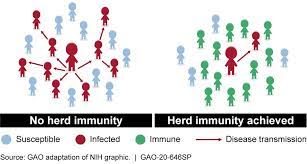Herd immunity is a method of preventing the spread of an infectious disease through achieving a high rate of natural or vaccine-acquired immunity within a population (Biscontini, 2020). Herd Immunity reduces or eliminates the spread among the unprotected and protected alike. Herd immunity is not so much a function of getting a disease or not, but rather preventing transmission of the disease-causing organism, with immunity falling upon a spectrum depending on immune function, health, environment, and individual, causative organism, and society factors (Robertson, 2021). Robertson supported this idea of a spectrum by providing examples of many factors that lead to herd immunity. He discussed brucellosis in cattle, the so-called contagious abortion, and how isolating the mother cow and allowing her to recover left both her and her offspring usually immune to further disease. He pointed out that free range animals are far less likely to contract disease than those kept in enclosed spaces, such as dairy cows. He wrote about infecting parasites and mechanism of spread (e.g., how easy it was to spread and exposure to risk factors for spread such as eating undercooked infected meat). He also discussed diphtheria and the partial immunity among poorer schoolchildren that had repeated low-dose exposures within their crowded communities and were thereby less susceptible to severe infection. He described antigenic shift (small changes to an organism over time that changes how it infects, how infective it is) in influenza virus, and how that affects resistance to new variants of influenza related to being previously infected with others. Robertson wrote that eventually the term herd immunity came to be known as a function of how many individuals were immune (a binary event), which has led to the misunderstanding of the term amongst the public. Note that all previous examples indicated chance rather than complete protection. People who are vaccinated can often still get and transmit the disease-causing organism, and likewise those previously infected with the organism can be infected again. Herd immunity is rather a balance achieved between a host, an infecting organism, and the herd, or population of interest, resulting in reduced or eliminated disease transmission (Robertson, 2021).
Lets consider for a moment that a mother brings in her baby for immunizations, but states that she wants to skip the ones due this month, because she figures that herd immunity will protect her baby. Again, based on the definition above, herd immunity refers to resistance to spread, rather than individual infection (Robertson, 2021). Herd immunity is an important topic to discuss when trying to control disease transmission that is, or previously was, rampant and resulted in poor outcomes in terms of mortality and morbidity (death and disability respectively). It is not so important when discussing individual protection for a baby. This mother is likely seeing herd immunity as a binary, and as an individual protective strategy, which it is not. For example, in the current coronavirus 2019 (COVID-19) pandemic, people choose to get vaccinated because they are either worried about getting infected for the first time or again (individual immunity), or they are worried about infecting their elderly or immunocompromised loved ones (herd immunity), or both. Relying on herd immunity does not protect the baby from infection, rather it protects the population from transmission.
This visit with the mother and infant should be used as an opportunity to discuss this mother’s fears and concerns. There are several common fears that lead to vaccine hesitancy, including the belief that immunizations such as MMR can cause autism (based on a fraudulent Wakefield study published in 1998 and subsequently retracted), vaccines will cause the disease or make a child very ill, and parental beliefs that children are no longer at risk for the diseases vaccines protect against (Pluviano et al., 2019). Some parents are also distrustful of pharmaceutical companies and believe they are just out to profit off children and adults, and others believe that receiving multiple vaccinations at once overwhelms the immune system, leading to significant problems later in life (Geoghegan et al., 2020). The article by Geoghegan et al. (2020) lists common vaccine myths and then goes over the evidence against each systematically and could be used as an excellent source for educating parents.
References
America’s Health Rankings. (2020). Annual report: Childhood immunizations. Retrieved Nov. 7, 2021, from https://www.americashealthrankings.org/explore/annual/measure/Immunize_b/state/MT
Biscontini, T. (2020). Herd Immunity. Salem Press Encyclopedia of Health.
Centers for Disease Control and Prevention (CDC). (2021). Immunization schedules. Retrieved Nov 7, 2021, from https://www.cdc.gov/vaccines/schedules/hcp/imz/child-adolescent.html#note-mening
Geoghegan, S., O’Callaghan, K. P., & Offit, P. A. (2020). Vaccine Safety: Myths and Misinformation. Frontiers in Microbiology, 1–7.
Pluviano, S., Watt, C., Ragazzini, G., & Della Sala, S. (2019). Parents’ beliefs in misinformation about vaccines are strengthened by pro-vaccine campaigns. Cognitive Processing, 20(3), 325–331. https://doi.org/10.1007/s10339-019-00919-w
Robertson, D. (2021). Of Mice and Schoolchildren: A Conceptual History of Herd Immunity. American Journal of Public Health, 111(8), 1473–1480. https://doi.org/10.2105/AJPH.2021.306264
Saslow, R. (2015, Feb 19). Where are all the anti-vaxxers? The Washington Post. Retrieved Nov. 7, 2021, from https://www.washingtonpost.com/news/parenting/wp/2015/02/19/where-are-all-the-anti-vaxxers/
